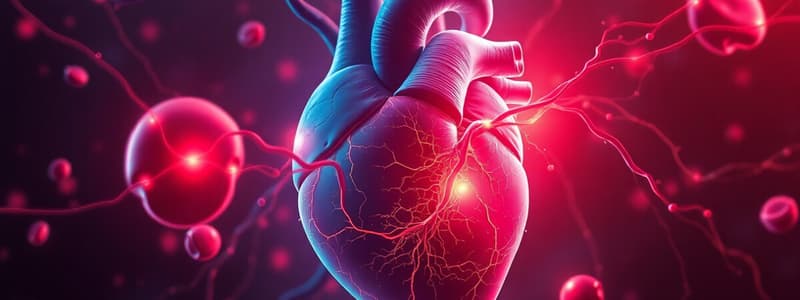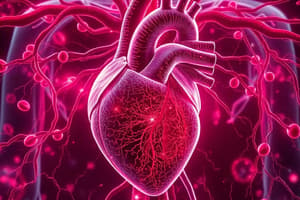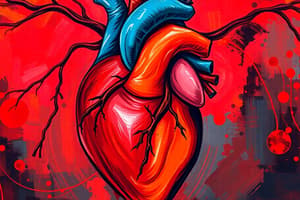Podcast
Questions and Answers
What is the primary function of the heart in the cardiovascular system?
What is the primary function of the heart in the cardiovascular system?
- Filter waste from blood
- Transport nutrients to tissues
- Pump blood throughout the body (correct)
- Regulate blood pressure
Which blood vessels are responsible for returning blood to the heart?
Which blood vessels are responsible for returning blood to the heart?
- Venules
- Veins (correct)
- Capillaries
- Arteries
What makes blood a unique connective tissue?
What makes blood a unique connective tissue?
- It is composed primarily of fibers
- It can regenerate itself
- It contains only one type of cell
- It has a liquid matrix called plasma (correct)
Which component of blood constitutes the majority of its composition?
Which component of blood constitutes the majority of its composition?
Which of the following is NOT a role of blood?
Which of the following is NOT a role of blood?
What percentage of plasma is made up of water?
What percentage of plasma is made up of water?
Which substances are dissolved in the plasma solutes?
Which substances are dissolved in the plasma solutes?
What are the protein components of plasma primarily responsible for?
What are the protein components of plasma primarily responsible for?
What stimulates an increase in erythropoietin secretion by the kidneys?
What stimulates an increase in erythropoietin secretion by the kidneys?
What percentage of leukocytes are neutrophils in a normal white blood cell count?
What percentage of leukocytes are neutrophils in a normal white blood cell count?
Which type of granules contain bactericidal agents such as lysozyme in neutrophils?
Which type of granules contain bactericidal agents such as lysozyme in neutrophils?
What is the duration of time neutrophils typically spend in circulation before reaching sites of infection?
What is the duration of time neutrophils typically spend in circulation before reaching sites of infection?
What is the role of fibrin threads in the clotting process?
What is the role of fibrin threads in the clotting process?
What is a common characteristic of granulocytes?
What is a common characteristic of granulocytes?
Which type of cells can give rise to both red blood cells and platelets?
Which type of cells can give rise to both red blood cells and platelets?
What happens to erythropoietin secretion when blood oxygen levels are raised due to increased red blood cell production?
What happens to erythropoietin secretion when blood oxygen levels are raised due to increased red blood cell production?
What happens to carbonic acid in the lungs?
What happens to carbonic acid in the lungs?
What is the primary role of erythropoietin?
What is the primary role of erythropoietin?
Which vitamin is essential for the production of red blood cells?
Which vitamin is essential for the production of red blood cells?
In what environment does carbonic acid dissociation primarily occur?
In what environment does carbonic acid dissociation primarily occur?
What causes a slight increase in blood pH in the lungs?
What causes a slight increase in blood pH in the lungs?
What happens to aged and damaged red blood cells?
What happens to aged and damaged red blood cells?
What is the average lifespan of a red blood cell?
What is the average lifespan of a red blood cell?
What occurs in red bone marrow as a person ages?
What occurs in red bone marrow as a person ages?
What is the primary function of erythrocytes?
What is the primary function of erythrocytes?
Which statement is correct regarding sickle cell anemia?
Which statement is correct regarding sickle cell anemia?
What is the significance of hemoglobin saturation in blood?
What is the significance of hemoglobin saturation in blood?
What structural feature of erythrocytes helps facilitate their function?
What structural feature of erythrocytes helps facilitate their function?
Which of the following describes the composition of hemoglobin?
Which of the following describes the composition of hemoglobin?
What happens to hemoglobin at low oxygen tension?
What happens to hemoglobin at low oxygen tension?
What role do the iron atoms in heme groups play?
What role do the iron atoms in heme groups play?
What structural change occurs in erythrocytes in sickle cell anemia?
What structural change occurs in erythrocytes in sickle cell anemia?
What percentage of oxygen is transported as oxyhemoglobin in the blood?
What percentage of oxygen is transported as oxyhemoglobin in the blood?
Which condition would favor the binding of carbon monoxide to hemoglobin over oxygen?
Which condition would favor the binding of carbon monoxide to hemoglobin over oxygen?
How is the majority of carbon dioxide transported in the blood?
How is the majority of carbon dioxide transported in the blood?
What role does carbonic anhydrase play in the transport of carbon dioxide?
What role does carbonic anhydrase play in the transport of carbon dioxide?
What is the established pH range maintained by the buffer system in the body?
What is the established pH range maintained by the buffer system in the body?
Which form of carbon dioxide accounts for 23% of its transport in the body?
Which form of carbon dioxide accounts for 23% of its transport in the body?
What is the consequence of increased carbon dioxide reacting with water in the blood?
What is the consequence of increased carbon dioxide reacting with water in the blood?
Which is true regarding the bond strength of carbon monoxide compared to oxygen?
Which is true regarding the bond strength of carbon monoxide compared to oxygen?
What role do phagocytic cells play in the healing process?
What role do phagocytic cells play in the healing process?
What is necessary for the intrinsic pathway of coagulation?
What is necessary for the intrinsic pathway of coagulation?
Why do individuals with hemophilia experience prolonged bleeding?
Why do individuals with hemophilia experience prolonged bleeding?
How does Coumarin affect blood clotting?
How does Coumarin affect blood clotting?
What happens to clotting if calcium ions are removed?
What happens to clotting if calcium ions are removed?
What factor enhances the clotting process during tissue damage?
What factor enhances the clotting process during tissue damage?
What is the effect of administering Vitamin K in the context of clotting?
What is the effect of administering Vitamin K in the context of clotting?
Which of the following statements about external wounds is true?
Which of the following statements about external wounds is true?
Flashcards
What is the function of the heart?
What is the function of the heart?
The organ responsible for pumping blood throughout the body.
What are arteries?
What are arteries?
Blood vessels that carry blood away from the heart to various organs and tissues.
What are veins?
What are veins?
Blood vessels that carry blood back to the heart from organs and tissues.
What are capillaries?
What are capillaries?
Signup and view all the flashcards
What is plasma?
What is plasma?
Signup and view all the flashcards
What is albumin?
What is albumin?
Signup and view all the flashcards
What are fibrinogens?
What are fibrinogens?
Signup and view all the flashcards
What are globulins?
What are globulins?
Signup and view all the flashcards
Oxyhemoglobin
Oxyhemoglobin
Signup and view all the flashcards
Carboxyhemoglobin
Carboxyhemoglobin
Signup and view all the flashcards
CO2 Dissolved in Plasma
CO2 Dissolved in Plasma
Signup and view all the flashcards
Carbaminohemoglobin
Carbaminohemoglobin
Signup and view all the flashcards
Carbonic Anhydrase Reaction
Carbonic Anhydrase Reaction
Signup and view all the flashcards
Blood Buffer System
Blood Buffer System
Signup and view all the flashcards
Carbonic Anhydrase
Carbonic Anhydrase
Signup and view all the flashcards
Chloride Shift
Chloride Shift
Signup and view all the flashcards
What is the function of Erythrocytes?
What is the function of Erythrocytes?
Signup and view all the flashcards
What is Rouleaux formation?
What is Rouleaux formation?
Signup and view all the flashcards
What causes Sickle Cells?
What causes Sickle Cells?
Signup and view all the flashcards
How do Sickle Cells cause Anemia Crisis?
How do Sickle Cells cause Anemia Crisis?
Signup and view all the flashcards
What is the structure of Hemoglobin?
What is the structure of Hemoglobin?
Signup and view all the flashcards
How does Hemoglobin bind and release oxygen?
How does Hemoglobin bind and release oxygen?
Signup and view all the flashcards
What is Hemoglobin saturation?
What is Hemoglobin saturation?
Signup and view all the flashcards
What is the function of Carbonic Anhydrase?
What is the function of Carbonic Anhydrase?
Signup and view all the flashcards
Erythropoiesis
Erythropoiesis
Signup and view all the flashcards
Erythropoietin
Erythropoietin
Signup and view all the flashcards
Pleuripotential stem cell
Pleuripotential stem cell
Signup and view all the flashcards
Plasma
Plasma
Signup and view all the flashcards
Albumin
Albumin
Signup and view all the flashcards
Fibrinogens
Fibrinogens
Signup and view all the flashcards
Globulins
Globulins
Signup and view all the flashcards
Myeloid tissue
Myeloid tissue
Signup and view all the flashcards
Erythropoietin (EPO)
Erythropoietin (EPO)
Signup and view all the flashcards
Hypoxia
Hypoxia
Signup and view all the flashcards
Neutrophils
Neutrophils
Signup and view all the flashcards
Phagocytosis
Phagocytosis
Signup and view all the flashcards
Basophils
Basophils
Signup and view all the flashcards
Coagulation
Coagulation
Signup and view all the flashcards
Fibrin
Fibrin
Signup and view all the flashcards
Extrinsic Pathway
Extrinsic Pathway
Signup and view all the flashcards
Intrinsic Pathway
Intrinsic Pathway
Signup and view all the flashcards
Hemophilia
Hemophilia
Signup and view all the flashcards
Vitamin K
Vitamin K
Signup and view all the flashcards
Coumarin
Coumarin
Signup and view all the flashcards
Heparin
Heparin
Signup and view all the flashcards
Antithrombin III
Antithrombin III
Signup and view all the flashcards
Thrombin
Thrombin
Signup and view all the flashcards
Study Notes
Blood Overview
- Blood is a complex tissue, part of the connective tissue group, derived from mesenchyme cells.
- The fluid portion of blood is called plasma.
- Plasma makes up 55% of the total blood volume.
Cardiovascular System Components
- Heart: pumps blood
- Blood Vessels:
- Arteries: carry blood to organs and tissues
- Veins: return blood to the heart
- Capillaries: allow transport to and from tissues
- Blood: the fluid medium for transport
Blood Composition
- Plasma:
- 91+% water
- Solutes: nutrients, wastes, blood gases, electrolytes, regulatory molecules
- Proteins: albumin, fibrinogens, globulins
- Formed elements (cells and derivatives make up 45% of total blood volume, =Hematocrit)
- Erythrocytes (red blood cells): 5 x 106/mm3
- Leukocytes (white blood cells): 5-10 x 103 /mm3
- Thrombocytes (platelets): 150-200 x 103 /mm3
Plasma Proteins
- Albumins: 65%, osmolarity and viscosity
- Globulins: transport and storage proteins
- Transferrin: carries iron in blood
- Ferritin: stores iron in liver and marrow
- Antibodies
- Fibrinogens: clotting proteins
Erythrocytes (Red Blood Cells)
- Biconcave disks, optimizing volume and surface area for storage and transport
- No nuclei or organelles, simple enzyme systems
- Function: carry oxygen and carbon dioxide using hemoglobin.
Sickle Cell Anemia
- A point mutation in the globin gene causes hemoglobin S (HbS)
- HbS aggregation causes loss of cell plasticity and comma-shaped cells under low oxygen tension
- The substituted amino acid changes the hemoglobin structure and leads to the formation of fibrous structures when oxygen tension is low
- Sickled cells get stuck in capillaries, decreasing blood flow
Hemoglobin
- Comprised of four polypeptide chains (2 alpha and 2 beta), each with a heme group.
- Heme groups contain iron atoms that bind oxygen.
- Hemoglobin also binds carbon monoxide
Oxygen Transport
- 98% of oxygen is transported bound to hemoglobin (oxyhemoglobin)
- 2% of oxygen is dissolved in plasma.
Carbon Dioxide Transport
- 7% dissolved in plasma
- 23% attached to amino acids on globin (carbaminohemoglobin)
- 70% reacts with water to form carbonic acid
Blood Buffer System
- Maintains a narrow pH range (7.35-7.45) through equilibrium between a weak acid and its dissociation products
- Carbonic anhydrase is an enzyme in red blood cells that facilitates the conversion of CO2 to carbonic acid, an important part of buffer function
Erythropoiesis
- Production of red blood cells in the myeloid tissue of bone marrow.
- Erythropoietin, primarily produced by the kidney, stimulates erythropoiesis when blood oxygen levels are low
Leukocytes (White Blood Cells)
- Granulocytes: observable granules
- Neutrophils: 60-65% of leukocytes, active and passive phagocytes
- Eosinophils: 2%, important in allergic responses, inflammatory counteraction. Secrete anti-inflammatory chemical
- Basophils: <1%, mediate inflammatory reactions, release histamine and heparin-like molecules
- Agranulocytes: no observable granules
- Lymphocytes: 25-30%, B cells: antibody production, T cells: cell-mediated immunity, Natural killer cells.
- Monocytes: ~9%, transform into macrophages in connective tissue, critical in wound healing and phagocytosis.
Platelets (Thrombocytes)
- Cellular derivatives from megakaryocytes
- Fragmented cells containing factors essential for the intrinsic blood-clotting mechanism.
- They play an important role in hemostasis
Hemostasis
- Arrest of bleeding
- Three main phases:
- Platelet plug formation
- Vascular spasm
- Coagulation
Intrinsic vs. Extrinsic Clotting Pathways
- Intrinsic: relies on factors already present in blood, activated upon damage to the blood vessel.
- Extrinsic: enhanced by factors from damaged tissue, faster clotting than intrinsic pathway.
Vitamin K
- Required for the synthesis of certain clotting factors in the extrinsic pathway.
Anti-coagulants
- Heparin: potentiates anti-thrombin.
- Coumarin: competes with vitamin K, for protein production essential to the clotting process.
Other Factors in Clotting
- Serotonin: causes vasoconstriction
- Ice: used to cause vasoconstriction
- Compression: reduces blood flow in order to enhance clotting.
Studying That Suits You
Use AI to generate personalized quizzes and flashcards to suit your learning preferences.
Related Documents
Description
Test your knowledge on the cardiovascular system with this quiz, covering the heart's function, blood vessels, and the unique characteristics of blood as a connective tissue. Explore the roles of blood, plasma composition, and more to reinforce your understanding of this vital system.




